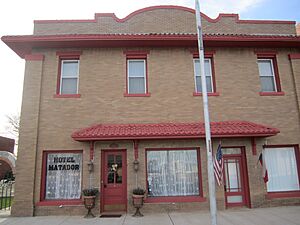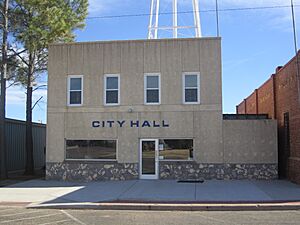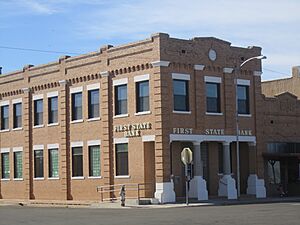Matador, Texas facts for kids
Quick facts for kids
Matador, Texas
|
|
|---|---|
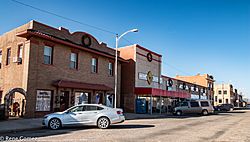 |
|
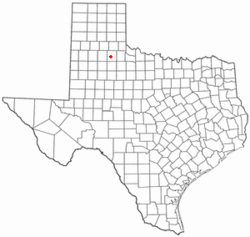
Location of Matador, Texas
|
|
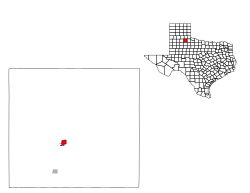 |
|
| Country | United States |
| State | Texas |
| County | Motley |
| Area | |
| • Total | 1.30 sq mi (3.38 km2) |
| • Land | 1.30 sq mi (3.38 km2) |
| • Water | 0.00 sq mi (0.00 km2) |
| Elevation | 2,382 ft (726 m) |
| Population
(2020)
|
|
| • Total | 569 |
| • Density | 437.7/sq mi (168.3/km2) |
| Time zone | UTC-6 (Central (CST)) |
| • Summer (DST) | UTC-5 (CDT) |
| ZIP code |
79244
|
| Area code(s) | 806 |
| FIPS code | 48-47004 |
| GNIS feature ID | 1362272 |
Matador is a small town in Texas, United States. It is the main town and the "county seat" of Motley County. A county seat is like the capital city of a county, where the local government offices are.
In 2020, about 569 people lived in Matador. The town was started in 1891 and got its name from the Matador Ranch. It is located about 95 miles (153 km) east of Lubbock.
Contents
History of Matador
The Matador Ranch was created in 1882 by a group from Scotland. A post office opened in Matador in 1886.
Around the late 1800s, the people of Matador worked to make their community independent from the large Matador Ranch. They encouraged non-ranch families to move there. They also elected their own town leaders. The ranch itself was eventually closed down in 1951.
The community officially became a town in 1912. It was also made the county seat. At that time, the state of Texas required towns to have at least 20 businesses to be a county seat. To meet this rule, local ranch workers set up some temporary, fake businesses using ranch supplies. The only real business in Matador back then was a saloon.
Matador's population was highest in 1940, with 1,376 people living there.
2023 Tornado Event
On June 21, 2023, a very strong tornado hit Matador. It was an EF3 tornado, which means it caused a lot of damage. Sadly, four people died and ten were hurt. At least 20 homes and businesses on the west side of town were destroyed.
Geography of Matador
Matador is located at 34°0′50″N 100°49′18″W. This is its exact spot on a map.
The United States Census Bureau says the town covers about 1.3 square miles (3.38 square kilometers). All of this area is land.
Matador is found where several major roads meet. These include US Route 62, U.S. Route 70, and State Highway 70.
Climate and Weather
Matador has a semiarid climate. This means it's usually dry, but not a desert. It gets some rain, but not a lot.
The table below shows the typical weather in Matador throughout the year. It includes average temperatures and how much rain and snow the town usually gets.
| Climate data for Matador, Texas (1991–2020 normals, extremes 1947–present) | |||||||||||||
|---|---|---|---|---|---|---|---|---|---|---|---|---|---|
| Month | Jan | Feb | Mar | Apr | May | Jun | Jul | Aug | Sep | Oct | Nov | Dec | Year |
| Record high °F (°C) | 87 (31) |
93 (34) |
100 (38) |
106 (41) |
110 (43) |
116 (47) |
113 (45) |
111 (44) |
106 (41) |
105 (41) |
94 (34) |
85 (29) |
116 (47) |
| Mean daily maximum °F (°C) | 53.7 (12.1) |
57.5 (14.2) |
66.3 (19.1) |
74.4 (23.6) |
82.3 (27.9) |
90.1 (32.3) |
93.4 (34.1) |
92.3 (33.5) |
84.5 (29.2) |
74.9 (23.8) |
63.3 (17.4) |
54.4 (12.4) |
73.9 (23.3) |
| Daily mean °F (°C) | 41.1 (5.1) |
43.9 (6.6) |
52.1 (11.2) |
60.0 (15.6) |
69.1 (20.6) |
77.5 (25.3) |
81.2 (27.3) |
80.0 (26.7) |
72.2 (22.3) |
61.8 (16.6) |
50.4 (10.2) |
42.2 (5.7) |
61.0 (16.1) |
| Mean daily minimum °F (°C) | 28.4 (−2.0) |
30.3 (−0.9) |
37.9 (3.3) |
45.6 (7.6) |
56.0 (13.3) |
64.9 (18.3) |
69.0 (20.6) |
67.8 (19.9) |
59.9 (15.5) |
48.7 (9.3) |
37.5 (3.1) |
30.0 (−1.1) |
48.0 (8.9) |
| Record low °F (°C) | −4 (−20) |
−6 (−21) |
3 (−16) |
22 (−6) |
32 (0) |
46 (8) |
54 (12) |
52 (11) |
37 (3) |
18 (−8) |
10 (−12) |
−5 (−21) |
−6 (−21) |
| Average precipitation inches (mm) | 0.81 (21) |
0.89 (23) |
1.45 (37) |
1.96 (50) |
2.77 (70) |
3.44 (87) |
2.03 (52) |
2.68 (68) |
2.99 (76) |
1.89 (48) |
1.08 (27) |
0.99 (25) |
22.98 (584) |
| Average snowfall inches (cm) | 1.4 (3.6) |
1.7 (4.3) |
0.3 (0.76) |
0.1 (0.25) |
0.0 (0.0) |
0.0 (0.0) |
0.0 (0.0) |
0.0 (0.0) |
0.0 (0.0) |
0.1 (0.25) |
0.9 (2.3) |
2.0 (5.1) |
6.5 (17) |
| Average precipitation days (≥ 0.01 in) | 3.2 | 3.7 | 4.7 | 4.6 | 6.7 | 6.8 | 5.1 | 6.4 | 5.9 | 4.9 | 3.5 | 3.3 | 58.8 |
| Average snowy days (≥ 0.1 in) | 0.9 | 1.0 | 0.3 | 0.1 | 0.0 | 0.0 | 0.0 | 0.0 | 0.0 | 0.1 | 0.5 | 1.0 | 3.9 |
| Source: NOAA | |||||||||||||
Population Changes
This table shows how the population of Matador has changed over the years, according to the U.S. Census.
| Historical population | |||
|---|---|---|---|
| Census | Pop. | %± | |
| 1920 | 692 | — | |
| 1930 | 1,302 | 88.2% | |
| 1940 | 1,376 | 5.7% | |
| 1950 | 1,335 | −3.0% | |
| 1960 | 1,217 | −8.8% | |
| 1970 | 1,091 | −10.4% | |
| 1980 | 1,052 | −3.6% | |
| 1990 | 790 | −24.9% | |
| 2000 | 740 | −6.3% | |
| 2010 | 607 | −18.0% | |
| 2020 | 569 | −6.3% | |
| U.S. Decennial Census | |||
Who Lives in Matador? (2020 Census)
The 2020 United States census counted 569 people living in Matador. There were 273 households and 190 families.
This table shows the different groups of people living in Matador in 2020:
| Race | Number | Percentage |
|---|---|---|
| White (NH) | 436 | 76.63% |
| Hispanic or Latino | 100 | 17.57% |
| Black or African American (NH) | 7 | 1.23% |
| Some Other Race (NH) | 1 | 0.18% |
| Mixed/Multi-Racial (NH) | 25 | 4.39% |
| Total | 569 |
Fun Places to Visit
Matador has some interesting historical spots.
Hotel Matador
The Hotel Matador was first called the Carter Hotel. It was built in 1914 by Roy Carter and his wife, Jessie Simpson. For a small town, the hotel had very fancy rooms. It even had a bellhop, a full-time gardener, and laundry service.
The hotel had 15 rooms, a dining room, and one large bathroom with a big oak tub. There was also an ice cream parlor that ran along the lobby until the 1920s.
The name "Hotel Matador" was given to it in the 1920s. The hotel changed owners many times. Judge C.B. Whitten made it a popular place for community meetings, parties, and dances for young people. In 1941, Warren Clements bought the hotel. He changed the ice cream parlor into a barber shop. He and his wife, Faye, also lived in an apartment behind the hotel. Mrs. Clements had a beautiful English garden with award-winning irises. The hotel became known for its fun events.
In 1980, Johnny and Evelyn Jackson bought the hotel and turned it into apartments. Later, it became a single home and was empty for five years. Then, three sisters, Marilyn Hicks, Linda Roy, and Caron Perkins, bought it. They worked to fix up and restore the historic building. Now, the sisters run the Matador as an eight-room bed and breakfast. The old barber shop is now a special suite called the Circle Cross Heritage suite. It still has its original tin ceiling and fancy bathroom fixtures.
Traweek House
Dr. Albert Carroll Traweek, Sr., was a doctor in Matador. He was known as the "pneumonia doctor" because he was very good at treating patients with this serious illness. He was the first public health officer for Motley County. He also started the Traweek Hospital, which is now the Motley County Historical Museum.
In 1915, Dr. Traweek started building his home, the Traweek House. It was designed by Charles Stephen Oates, who was Dr. Traweek's uncle and a famous builder in West Texas. The large, two-story house was finished in 1916 and cost $14,000. It combines different styles of architecture, including Classical Renaissance, Prairie, and Classical Revival architecture.
Many important people visited the Traweek House. These included Baldwin Parker, who was the son of Quanah Parker, the last chief of the Comanche tribe. State and national officials also visited. The house is located at 927 Lariat Street in Matador and is still owned by the Traweek family. In 1964, it received an official historical marker. In 1990, it was named a Texas Historic Landmark.
Bob's Oil Well
Luther Bedford "Bob" Robertson moved to Matador in the 1920s. He started as a gas station attendant. Later, he opened his own Conoco gas station. To make his business stand out, he put a decorative wooden oil derrick on top of it. He even got a patent for his design! In 1939, he replaced the wooden derrick with a steel one that was 84 feet (26 meters) tall and lit up.
Bob Robertson was very creative in advertising his business. He kept a cage of live rattlesnakes for tourists to see. Later, he added a small zoo with lions, monkeys, coyotes, and even a white buffalo! He also paid long-distance truck drivers to put up signs across the United States. These signs told people how many miles it was to Bob's Oil Well in Matador.
Matador is about the same distance from Dallas and Carlsbad, New Mexico. It's also 9 miles (14 km) closer to Denver than to El Paso. Bob soon added a grocery store, a café, and a garage to his business. He was also a leader in Matador and wanted to honor soldiers returning from World War II.
Bob Robertson passed away in 1947. Just two weeks later, a strong wind knocked down his famous steel derrick. His wife, Olga Cunningham, rebuilt it in 1949 with even brighter lights. Eventually, the business closed. Today, the site at the intersection of U.S. Route 70 and State Highway 70 reminds us of a time when roadside attractions were new and exciting. It also shows how one man worked hard to promote his adopted hometown.
Education in Matador
The town of Matador is part of the Motley County Independent School District. Students in Matador attend Motley County High School, and their sports teams are called the Matadors.
Famous People from Matador
- Karen Elliott House: A journalist who won a Pulitzer Prize and used to be a leader at Dow Jones International.
- Roy Ratcliff: A Christian minister who was born in Matador.
- Stanley Rose: A famous Hollywood bookseller from the 1930s, also born in Matador.
See also
 In Spanish: Matador (Texas) para niños
In Spanish: Matador (Texas) para niños


